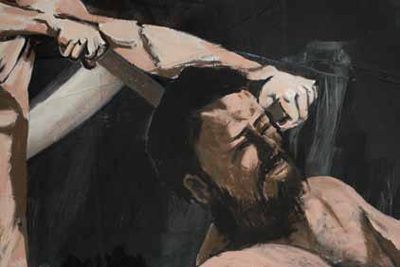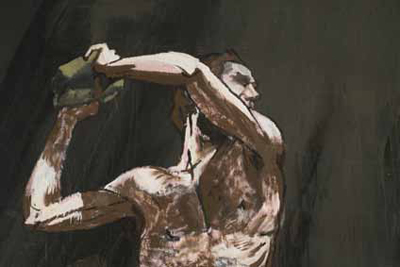AUTHOR: IVO MARTINS IMAGES: HUGO CANOILAS - ENDLESS KILLING [DETAILES] (2009) BY JORGE NEVES
EDITION: (Catalogue) Centro Cultural Vila Flor DATE: December 2011
A few years ago I bought the book Austerlitz, by W.G. Sebald. I did this in the usual way: I went to a bookshop, I
chose the book, I paid for it at the counter and I came back home. I read it for some days, and when I came to the
end I came across a hand written inscription on the last page, of an almost illegible signature, an elongated shape
made in a single stroke, in such a manner that it was impossible for me to come to a conclusion about its origin or
authorship. This strange symbol appears to me every time I pick up the book again, leafing through it at random
in an absent-minded search for some details of the story that I missed the first time I read it. For me that work
has a double mark: the structure of the literary discourse itself, and that drawing, mark, sign that forces us to feel
the impossibility of hiding the contents of our consciousness in each person's intimacy, without letting them flow
out to the objects that are exterior to us. The first doubts appear to us when we try to decode a name that at first
sight seems easily legible to us but which then, just like that signature, after several attempts, is subdivided into
so many other possible forms of denomination, proving that in our awareness there is much more information
that what we believe exists. That capacity to double a knowledge, even through a doubt, tells us that certain
structures of knowledge would not be susceptible to be multiplied within a broad process of expansion if our
awareness were a mere objective mirror of what we observe. A small stimulus like that of a signature found by
chance at the end of a book, a moment captured as a singularity that goes against the normal run of the routine
facts of everyday activity, takes on a subjective charge that increases, gradually turning into an atypical sign, an
unknown code that is therefore closed to common interpretation. When we are faced with something we cannot
understand we conclude that our perception is vaster than what is contained in it, that it is able to fill the gap
with which it is confronted, deducing solutions of continuity, establishing links between separate moments
imposed from the outside in a non-authoritarian manner. In this sense we formulate a game of possibilities and
we carry out a rational operation with states of mind that might possess a certain content, albeit without
knowing whether these contents are real or not. From that moment on one may understand how the signatures
on a document, on a drawing or on a work do not go beyond a written mark, an attempt to personalise an object
created in order to have a life of its own outside of the context in which it was designed and made, informing us
about the intention of calling an end to each moment contained within it. One also understands that someone
wanted to, and felt there was a need to add something to that full stop and that, in placing their signature there,
suspended what was taking place.
In the works of Hugo Canoilas we feel indifference towards authorship and the usefulness of carrying out a final
signature on his work, which appears to us as interlinked within a circular continuity and in expansion, with it
being easier to detect the inaugural gesture of its origin than the final moment of its definitive conclusion. In his
work there seems to exist a latent rejection of the final gesture demanded as convention by artistic practice,
which signals the conclusion of a work of art, and the assumption of a "reverse authorship", concerned about
imposing the non-imposing of that end on all those who are to be found outside it and expect that sign. This sort
of suspension suggests to us the artist's pressing need to wipe the slate clean as to his past, even his recent past,
and to re-take up the terminal limit of the previous work at the beginning of each new one. Thus there is a
present moment from which he does not abdicate and which is eternalised, insistently being renewed through the
filter of the critical examination to which he subjects himself in the ultimate effort of a search for truth situated
in the absolute certainty of his presence before himself. Each work will be of worth as much for its beginning as
for its end: it is a space among spaces. Its time of being carried out bears rigorous and aware attention to all
opinions, beliefs, preconceived ideas and tendencies, becoming removed from them in order to be emptied of
them immediately afterwards, preparing a founding moment from that nothingness, one which is imposed as a
stripping of the subject in its relationship with itself. He claims the urgency of a struggle against our tendency to
establish a connection of causality on the things we see, granting them order. Avoiding the influence that this
cause and effect relationship produces in us presupposes establishing a distance over a feeling of destiny that
seems to determine the sequence of the works presented, allowing the critical connections revealed to be fitted
into a move up to a humanist level felt in the claiming of authenticity. The artist's voice is a voice that orders the
prohibition of order and that has nothing to state. This reclaiming of authenticity finds numerous equivalents in
the cultural field, circumscribed within the end of the distinctions between erudite culture and popular culture,
implied in the rejection of an outside authority, allowing the opening up of a space for personal liberation
expressed in its presence in front of itself and in the search for a totalizing harmony capable of including all
spiritual, ethical and aesthetic elements, among others.
The work thus becomes a mechanism that leads to a feeling of incompleteness and that the lack of finishing off is
the best response to be given to the questions that insist on the need for agreement between those who make and
those who receive art. It responds to this need of ours to feel included in the artistic process through agreement
and assent as to the final moment of each work, becoming a factor of normality and pacification that helps to
resolve the problems of reception and assimilation that are placed. In not giving objective signs that his process
has been concluded, there is the establishing of a cut in the vertical sequence of a story that does not find its role
in the granting of meaning. It is felt that when we acquire objects we then possess small automatic traces of a
repeated production that identify its conclusion and grant the work produced in them with an authenticity and a
sign of finishing that is determined by the final act. We possess a signature. We therefore think about the
intentions of this individual who goes on constructing his works in different ways and with different contents,
who expresses himself in a disorderly manner, uncommittedly using all kinds of materials and supports, letting
himself become involved in an almost underground process of acting in which one only understands the
successive twists that his apparent and unexpected activity allows one to see. What might be the motivations and
interior solutions for this world of the sensitive that the artist embodies and may have provoked this set of such
unusual facts, contained in the different works that are considered as carried out?
We imagine, therefore, a person who goes to a studio every day, takes a notebook of a shelf, sits down
comfortably on a stool and, as he reads it calmly over several days, jots down some little notes. When he finishes
this operation he signs it and puts it back very naturally in the same place. He ends this act of creation with a
note, adding a sign of his presence, a warning, an intromission. If we think that all of this takes place it the
utmost secrecy, inside a place protected from the public gaze, we might think that it is a new mechanism of
subversion against all the banalisations of the moment of creation, which have on occasion been subjected to the
most stupid media treatments. Observing the gesture that culminates the limit of artistic creation may result in a
series of infinite banalities suggested by the penetrating game of the retina or by the mechanical capturing of the
photography or film camera. On looking at Hugo Canoilas's works we only slightly, and increasingly less, read
the realities from which the facts circumscribed within them have come from within a layout of symbols and
signs that language adds to these unspeakable realities. These are acts in suspension, without an outcome of a
cause or effect that clearly define a lack of interest in a terminal finality. They are open spaces, laid out in the
contingency of the chance events that they read as if they had to be restarted at any moments and that, for this
very reason, do not structure commitments. Having access to the works, reading them and contaminating them
with our gazes does not require a signature, a legible sign that in this sense will be an opportunity for the artist to
not act, insinuating a new counter-activism of appropriation yet without acquiring property. As if we could go
into bookshops and read books and at the end of each reading place our signatures on each of them, provoking
an infraction on the property of those who come next to buy the object that in the meantime has become
something belonging to the anonymous person who signed it. Those who read anonymously in a bookshop or
individually look at an exhibition place a personal and indecipherable mark on the objects or works of art, as if at
the end of each one of the readings they signed a secret symbol of possession on the books or the works exhibited.
This unconscious act suggests the furtive activity of murder victimising the rights of culture, denying the value of
purchase and of the commercial practices of the whole business underlying it. Anyone who came after that
totalizing moment would know that others had been there before them and had left their mark, thus removing
the excitement of the aura of each first gaze that the act of reading or of observing art necessarily convokes.
Enjoyment cannot be revealed in that which one feels has already been consumed by the gazes of another who
has thus left his mark. Curiously, the artistic object will never be destroyed by a sign placed on a work that is
apprehended for the first time or which is observed without any restrictions, but by the incapacity of overcoming
the exclusivity of the act of possessing through one's gaze. Hugo Canoilas's work may be the witness to a refined
act of rejection as to a deal, which will positively kill the logic of propagation of the market of individualistic
culture. In a world in which individualistic and Hedonistic consumption is not far from the legitimate status of
the owner, and in which there is a crossing of diffuse market relationships, this art infiltrates ideas of satisfaction
and pleasure lived out serenely, rejecting notions of full possession or absolute property.
TRANSLATION: CLAUDIA PESTANA, DAVID ALAN PRESCOTT, ELISABETE SOUSA


